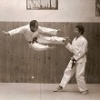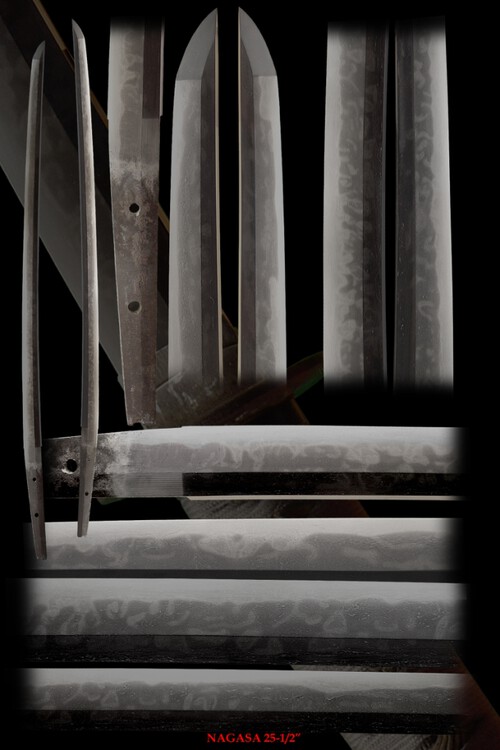-
Posts
8,632 -
Joined
-
Last visited
-
Days Won
51
Content Type
Profiles
Forums
Events
Store
Downloads
Gallery
Everything posted by Jean
-
Another link from Big Mo website : http://www.nihontoantiques.com/fss210.htm
-
The blade has a Shinto look. Nie appearing on the pictures, sunagashi .... Makes me think once again to this blade : http://www.swordsofjapan.com/Hocho.htm Or this one: http://www.artswords.com/022606akisuke.htm Could not it be a shortened shinshinto blade reviving good old Koto?
-
Dear John, Thanks a lot for this good answer which gives another angle for collecting Katana Tsubas. Depending on the blade nagasa, a 62cm katana can support a 7,2 cm Tsuba.
-
Then, can we state that there is no limit size for Katana tsuba and that the 3 inches which seems to be the border line between wak/katana tsuba is purely theoriticall and has no real foundation? From where come these 3 inches? Is this a western invention? In France, it is considered that, at 7,5 cm, a tsuba becomes katana size.
-
I have come across Daisho tsuba and it seems that there is no rules about the size of a Tsuba to be mounted on Katana though we consider katana size tsuba > 3 inches. ex : http://www.finesword.co.jp/sale/kodougu/htm/k073.htm I have also often seen small size tsubas mounted on Katana. Is there any rule about katana size tsuba? It is certain that from an aesthetic point of view an 8 cm tsuba on a 63 cmm katana looks odd.
-
Hi Doug, Neither do I. The style is easy to spot (even for a layman - and god, I know I'm one (extract from "The house of the Rising Sun" - LoL) but there are probably the most copied ones and they can vary tremendously in quality.
-
At first glance, It looks like a Soten Style Tsuba but I let Rich answer he is the authority
-
Jeremy, Getting back to your question, I have no picture of your entire blade but I can assure you from what I see that there is enough of Hamachi/Munemachi to have a polish done
-
My first thought was the same as Moriyama-san's one, broken tip of wakizashi or katana. What I dislike is the yokote (could be done by bad polishing), it looks a bit curved and the mitsugashira is not in line with the mitsukado as was spotted by William but above all, it is the Koshinogisuji which is far from following the fukura that I dislike most. Now, I won't say from such a picture ifl this sword is faked or not. Such a lousy picture in an auction makes me run away. I would not have given even a secong glance to the auction ... Things are clear : Don't waste money on gambling. Unless having the sword in hand and able to study it or able to get all the pictures you want and a full refund money guaranty in case of default not shown in the pictures, FORGET IT!!! IMHO, it is not worth more than 10 bucks in all events, genuine or fake
-
Hi Patrick, I think that in Sue Bizen (16th Century), blade quality speaking, nijimei is an intermediate between Bishu Osafune ...(kazu uchi mono) and Bizen no Kuni Ju Osafune ..(zoku mei). Above average mass production, easily papered, even TH level
-

nihonto french forum
Jean replied to takakage's topic in Sword Shows, Events, Community News and Legislation Issues
Hi Milt, Anyway you can always try German, I am sure that on the French Board some people are fluent in this idioma :lol: :lol: :lol: -
Hi Doug, Noshu means : Mino Province
-
"This sword has been the pride and joy of my family for the many years it has been in our family" I am shivering thinking to the rating of his family pride "Beati pauperes spiritu ..."
-
Hi Jacques, I don't think so but as pictures can be tricky, the advantage with Tsuruta san is that you've just have to ask and he will answer you by return mail. In fact when I buy a sword from him, I just send him a mail asking if there are kizu and what kind. I always get a straight forward answer from him. The only thing to be aware of when dealing with him is its conception of "polish blade". Unfortunately his standard does not always match mine :lol: :lol: :lol:
-
-
Always talking about the most discussed quality of Muromachi "Bishu Osafune ..." swords, here is one today on Aoi-Art site : http://www.aoi-art.com/sword/katana/06222.html This one has a nengo + an ubu nakago with one mekugi ana (not so frequent) . It is not a mass production sword but expensive for our American friends (11k$) but worth it. All Muromachi Bizen features are present and it is reflected in the price. From the pictures, hada is correct even if there are some very tiny kitae ware/loose hada, the blade has been polished a few times so that the soebi has been polished away in some areas. The only question : Kizu generally appear in the Hi and are seldom seen on pictures, I am not sure there are no kizu in the Hi, if one is tempted, he should inquire with Tsuruta san and ask him if it is TH level.
-
Hi, I don't know anything about tsuba, I learn a bit through Rich lectures which are as usual as sharp as my Hirosuke tanto, so I am going to give a layman observation (without the technical terms - forgive me): First Tsuba : What troubles me is that it seems there are sekigane and the upper one (corresponding to the cutting edge of the blade) seems to be cast or painted, it is the same for the other sekigane though some copper colour is showing. Something definitely fishy .. Second Tsuba : It seems very flat, brand new, no rust and what seems to be file marks clearly visible on the third picture... Once again, if not a specialist (and even ...) avoid e-bay, on-line auctions - unless knowing the Seller ..........
-
THIS IS FREE ADVERTISING FOR OUR FRENCH FORUM :lol: :lol: :lol: An Oustanding Lecture from Kanzan Sato on Nambokucho/Muromachi Hamon, the First part being on Hitatsura. Though, it is in French, you can copy and paste on any web translator to get it in English : http://token.alldiscussion.net/Etude-de ... hi-t86.htm
-

nihonto french forum
Jean replied to takakage's topic in Sword Shows, Events, Community News and Legislation Issues
Following Patrick topic, I have signed last night to become a member of this forum. It is outstanding (for a beginning) a lot of information available, a very good kantei section with good explanation (in fact, kantei/answers are I think almost as good as Darcy's ones). Darcy's kantei have an advantage, there are based on high resolution pictures and not oshigata. It is easier to work on Oshigata, because they show all what is to be seen in a blade (hataraki). I have notice that with the hadori, unless taking time to scrutinize a blade under different lights/angle, most time one shall miss important things. I am not sure that we are ready to draw Oshigata with all the precision needed ..... Language is not a problem, I have noticed that the more technical are the topics the easier they are understood, most terms being in Japanese. For all newbies a lot of information are available (drawings, Japaonese terms) English (even my poor one) not being an obstacle for most people, French should not be - even for our fluent German Bungo. Any way if some translations are needed I volunteer to help NMB members. -
Grasshoper, Have a look at the hamon, it is very regular (too regular), it seems to be carved and further more it goes off the cutting edge (someone has slipped with the dremel :lol: :lol: )
-
-
Having another look at the nakago picture, I shall add that the rust is quite reddish which could lead to an not-too-old nakago. Question : why reshape a totally new nakago?? is this because the blade is worth it? I hope so
-
Niji mei is not unusual with 16TH Bizen swordsmiths even if not mentionned in Fujishiro's book. I have seen quite a lot of Bizen papered blades (starting Eisho) with niji mei, here is an example : http://www.nihontoya.com/items/519322/en1nihontoya.html
-
Hi Patrick, Try this link http://www.swordsofjapan.com/Hocho.htm Seems to be very similar Hamon
-
Coming back from a fortnight holiday, Interesting sword as usual in this board. Just a feeling, but the picture of the whole blade makes me feel uneasy. The picture shows a very stout blade but the nakago seems to be an addition to a suriage katana, the yasurime are kiri and the munemachi and hamachi are incredibly crisp. Nevertheless the nakago is perfect an alternative : An o suriage Koto sword with a totally new nakago entirely reshaped. An ubu Shinto blade Hitatsura is a classical which is found as well in Soshu, Kaga, Bizen, Mino... If the blade is early Soshu, you should find very strong nie, late Soshu, the tobiyaki are crescent moon shaped and the nie tends to disappear - here is a picture of my hitatsura tsunahiro I got from big Mo, notice the crescent moon shaped tobiyaki typicall for late Soshu




